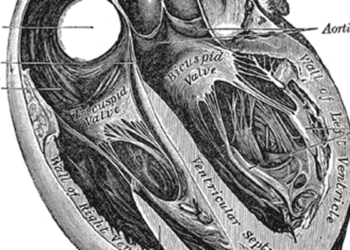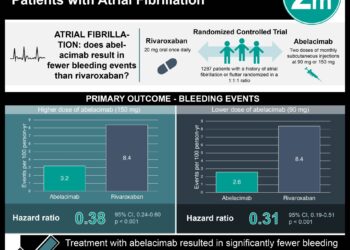Rivaroxaban does not decrease rates of venous thromboembolism complications after hospital discharge
1. At a median follow-up of 3.3 years, rates of symptomatic venous thromboembolism or death due to thromboembolism were similar for medically ill patients treated with rivaroxaban or placebo for 45 days following hospital discharge.
2. Major bleeding events occurred at similar rates for rivaroxaban or placebo treated patients.
Evidence Rating Level: 1 (Excellent)
Study Rundown: Patients hospitalized for acute illness of various etiologies are at increased risk for venous thromboembolism. Anticoagulant prophylaxis guidelines for discharged patients are rarely followed, though patients remain at elevated risk for thromboembolism after hospital discharge. The MARINER (Medically Ill Patient Assessment of Rivaroxaban versus Placebo in Reducing Post-Discharge Venous Thrombo-Embolism Risk) trial assessed rivaroxaban as a post-discharge treatment to reduce rates of venous thromboembolism in medically ill patients. The primary outcome, a composite of symptomatic venous thromboembolism or death, was not significantly different between rivaroxaban and placebo treated patients. Incidence of major bleeding was not significantly different between treatment or placebo patients.
Strengths of this study include its randomized design and low rate of loss to follow-up. Limitations include limited patient specific renal dosing of rivaroxaban and exclusion of patients hospitalized for 10 or more days.
Click to read the study in NEJM
Relevant Reading: Incidence of symptomatic venous thromboembolism after different elective or urgent surgical procedures
In-Depth [randomized controlled trial]: This randomized controlled trial enrolled patients between 2014 and 2018 and included patients from 36 countries. Eligible patients were 40 year of age or older, had been hospitalized for between 3 and 10 days, and were diagnosed with various major illnesses. Patients had to have an elevated risk for venous thromboembolism as defined by an international risk scoring system. At discharge, patients were randomized to receive either rivaroxaban (n=6007) or placebo (n=6012) for 45 days post-discharge. Patients were contacted at days 7, 21, 45, and approximately 75 post-discharge to assess for any symptoms of venous thromboembolism. The primary outcome of symptomatic venous thromboembolism or death related to thromboembolism occurred in 0.83% of treated and 1.10% of placebo patients (hazard ratio [HR], 0.76; 95% confidence interval [CI], 0.52 to 1.09; P=0.14). The primary outcome was assessed by subgroups according to creatinine clearance, which showed no difference in primary outcome between treatments. Occurrence of major bleeding occurred in 0.28% of treated and 0.15% of placebo patients (HR, 1.88; 95% CI, 0.84 to 4.23).
Image: PD
©2018 2 Minute Medicine, Inc. All rights reserved. No works may be reproduced without expressed written consent from 2 Minute Medicine, Inc. Inquire about licensing here. No article should be construed as medical advice and is not intended as such by the authors or by 2 Minute Medicine, Inc.





![Childhood ADHD associated with increased risk of suicide [Physician Comment]](https://www.2minutemedicine.com/wp-content/uploads/2013/03/PET-image1-e1377449984183-75x75.jpg)

